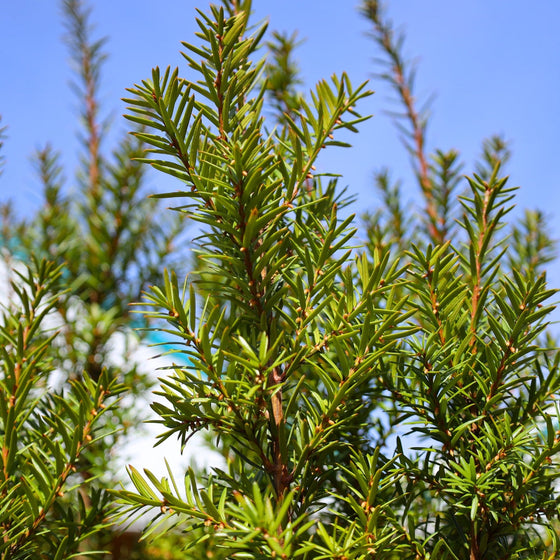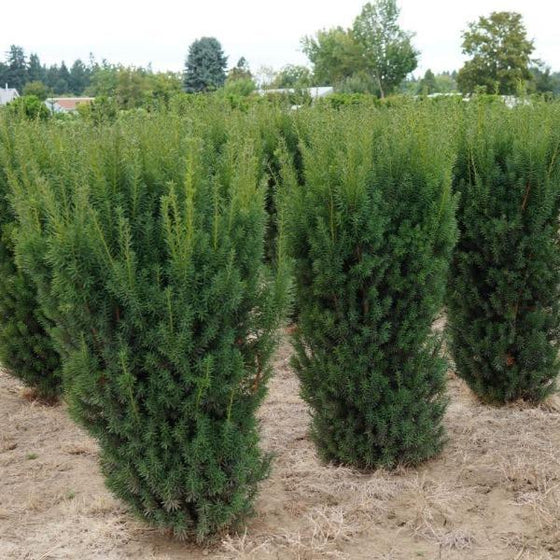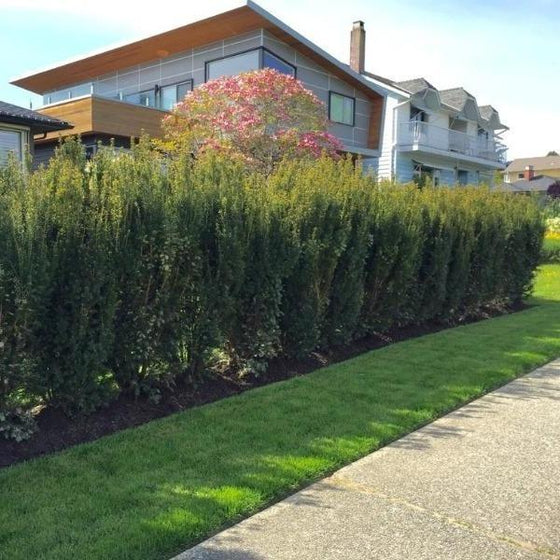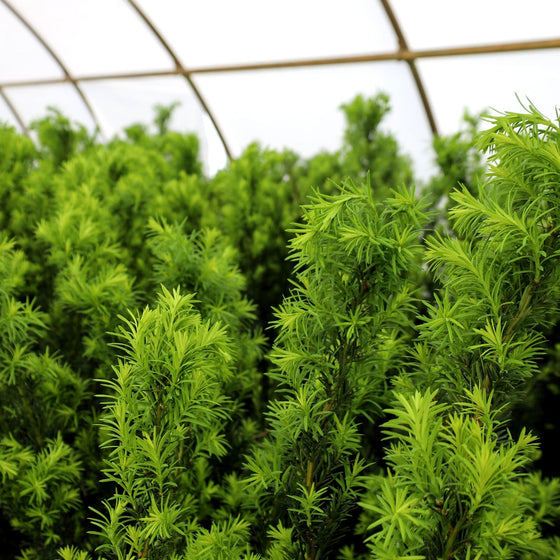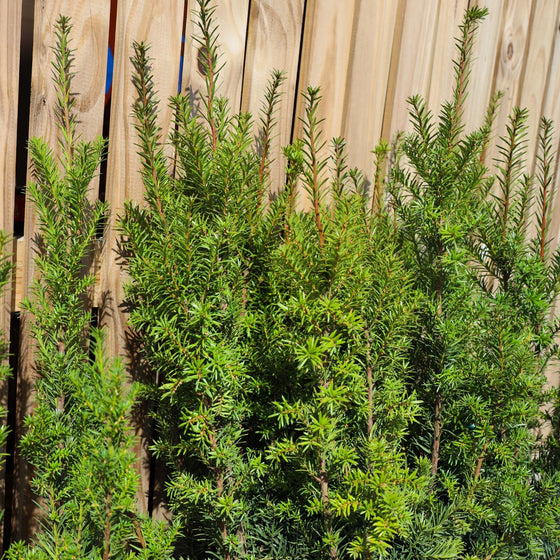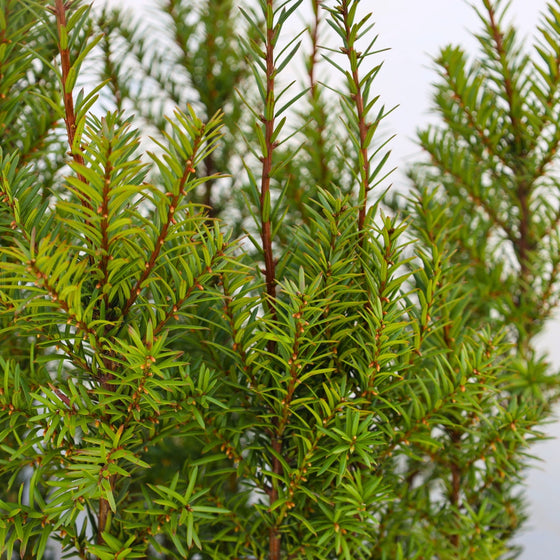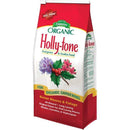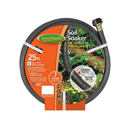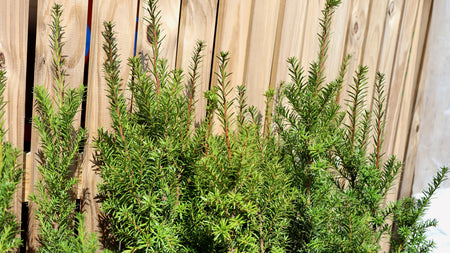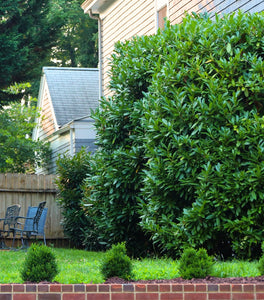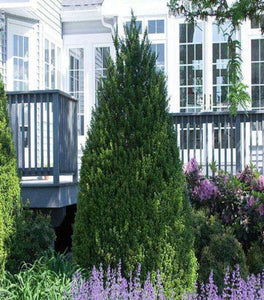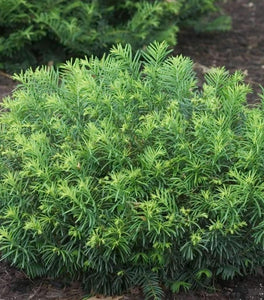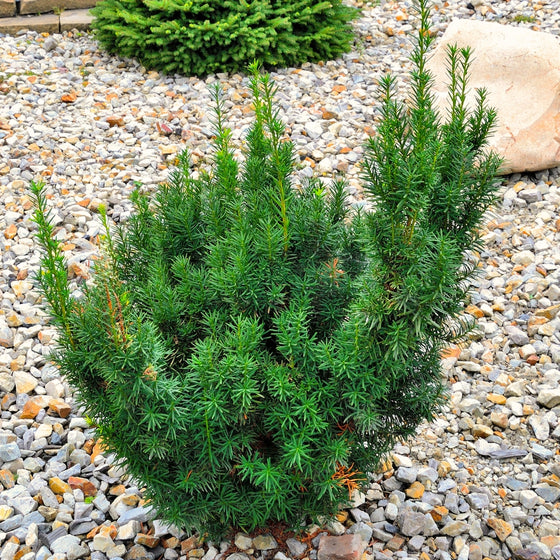
Images Depict Mature Plants
Hicks Yew – Upright Evergreen Hedge Shrub for Shade or Sun
A classic evergreen for formal hedges and foundations.
The Hicks Yew (Taxus x media ‘Hicksii’) is a timeless favorite among gardeners and landscapers looking for a dense, upright evergreen shrub with exceptional versatility. Known for its rich dark-green foliage and columnar growth habit, Hicks Yew is perfect for creating formal hedges, privacy screens, and foundation plantings that remain attractive throughout the year.
Deer-resistant and shade-tolerant.
One of the most significant advantages of Hicks Yew is its ability to thrive where other evergreens struggle. Unlike arborvitae or boxwood, Hicks Yew is both deer-resistant and highly shade-tolerant, making it a dependable choice for landscapes with mixed light conditions. It’s equally at home in sun-drenched borders or shadier foundation areas, providing consistent structure and color with minimal maintenance.
A slow-growing, low-maintenance evergreen.
Hicks Yew grows at a moderate pace of 6–12 inches per year, reaching heights of 10–12 feet tall and widths of 3–4 feet at maturity. This slow, steady growth makes it easy to maintain as a formal clipped hedge or allow it to develop naturally into a slender evergreen screen. Once established, Hicks Yew requires little more than occasional watering during dry spells and light pruning to maintain its shape.
Cold-hardy and long-lived.
Hardy in USDA Zones 4–7, Hicks Yew is built to withstand cold northern winters while maintaining its evergreen presence. With its long lifespan, deer resistance, shade adaptability, and elegant columnar habit, this shrub is an investment in lasting beauty and privacy for your landscape. Whether used as a living wall, accent plant, or foundation anchor, Hicks Yew continues to be a landscape essential.
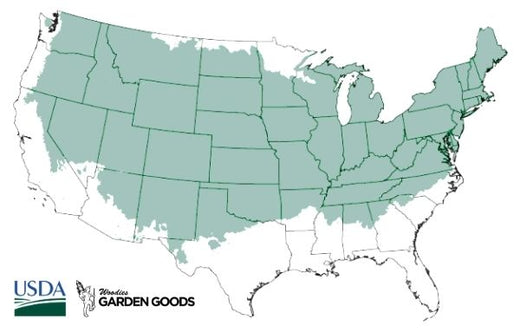
| Hardiness Zone: | 4-7 |
|---|---|
| Mature Height: | 10 to 12 feet |
| Mature width: | 3 to 4 feet |
| Classification: | Evergreen Shrub |
| Sunlight: | Full sun to part shade |
| Habit: | Upright, columnar |
| Foliage: | Dark Green |
| Pruning Season: | Prune in late winter before new growth or after new growth hardens off in summer |
| Soil Condition: | Any well drained slightly acidic soil |
| Water Requirement: | Water well until established |
| Uses: | Tolerates heat and drought; will adapt to slightly moist sites |
How to Care for Hicks Yew
In general, Hicks Yew is relatively easy to care for. Below are the guidelines to keep your Hicks Yew thriving in its new environment:

How do I plant Hicks Yew shrubs for a hedge or screen?
Plant Hicks Yews in well-drained soil and choose a location that receives full sun to partial shade. Dig a hole twice as wide as the root ball and as deep. Position the plant so the top of the root ball sits level with the soil surface, backfill halfway, water thoroughly, then complete backfilling and water again. For a hedge, space shrubs 2–3 feet apart to ensure a dense, uniform screen as they mature. Apply a 2–3 inch mulch layer around the base to help conserve moisture, regulate soil temperature, and reduce weed competition. Avoid planting in poorly drained soils, as yews prefer evenly moist conditions without sitting in water.
How often should I water Hicks Yew after planting?
During the first growing season, water deeply once or twice a week, allowing the soil to dry slightly between waterings. Consistent moisture helps the root system establish quickly. Avoid overwatering, as yews dislike soggy soil conditions. Once established, Hicks Yews are low-maintenance and drought-tolerant, needing only occasional watering during prolonged dry periods. Mulching helps retain soil moisture and reduces the frequency of watering.
When and how should I fertilize Hicks Yew?
Fertilize in early spring using a balanced, slow-release evergreen fertilizer to encourage lush foliage and steady growth. Apply evenly around the drip line and water thoroughly after feeding. Avoid fertilizing in late summer or fall, as this can stimulate tender new growth that may be damaged by frost. A single spring application is usually enough to keep your hedge healthy and vibrant.

Do Hicks Yew shrubs require pruning to stay attractive?
Hicks Yew naturally grows in a dense, upright form but responds well to pruning. For formal hedges, trim lightly in late spring to early summer after new growth appears. This encourages branching and a fuller appearance. If left untrimmed, Hicks Yews retain their elegant columnar habit, making them suitable for naturalistic plantings as well. Whether clipped or left to grow freely, their versatility makes them a favorite evergreen hedge shrub.

